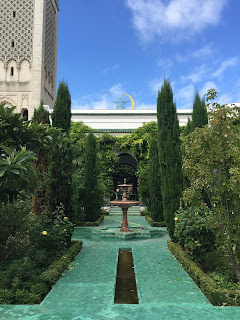So today we took our American openness to the Grande Mosquée and then to its attached café for lunch. Dr. Yahgoobi brought her class to the mosque with us as well. Click through for the details and pictures, s'il vous plaît?
We had the same tour guide, Yemina, as last year. She is very friendly, obviously loves her faith and is a great ambassador for a religion that is not always regarded positively. She's also patient with my imperfect skills as a translator, so I was happy to see her again!
The mosque was constructed between 1922 and 1926 from stone, marble, plaster, ceramic, and wood, with decorations in mosaic tile, stucco, and cedar of Lebanon. Most of the woodwork, several chandeliers, and some of the wall hangings were donated by imams and kings from other countries.
The horseshoe-shaped arches are typical of the "hispano-mauresque" style.
Stucco decorations--made of marble dust mixed with plaster. See the calligraphy inset?
Mosaic decoration--the dark brown tile above the mosaic has calligraphy that tells the story of the mosque in verse as well as representing some Koranic verses.
The crescent represents the Muslim lunar calendar. The star represents the 5 pillars of Islam: the shahadah, prayer 5 times a day, giving to the poor, observing Ramadan, and the hajj.
A square minaret, typical of North African mosques.
The students were very attentive through the tour and asked some good questions. I got a little tangled up in what I thought I remembered about Islam (from my high school World Religions class in 1990, cough cough) and Yemina had to set me straight but it all worked out. I learned from Dr. Yaghoobi that "shahadah," the name of the Muslim profession of faith ("There is no god but Allah, and Mohammed is his prophet, may peace be upon him") means "testimony." When Yemina recited it in French she said "Je temoigne que . . . " at the beginning: "I testify that . . . " Somehow the whole thing made a lot more sense to me after that.
We took pictures together:
Then we ate in the café. For unfamiliar food it's good to have un regard ouvert. If we learned nothing else today we learned what couscous is, what a tagine is, and why mint tea is a good idea. One student ordered "pastilla" and was surprised, although not displeased, to receive a meat pie. This is what I love about study abroad: you learn something everywhere you go!
Mint tea, y'all.
From "What's couscous?" to "Can we get more couscous?" in 1 hour or less.










Love knowing your students are learning! It is a valuable piece of knowledge that the American perspective isn't the only perspective! Voting this my favorite post!
ReplyDeleteThanks! They really bring the right attitude; all I have to do is put things in front of them to look at.
DeleteCous cous is definitely the right thing!
DeleteThis comment has been removed by a blog administrator.
ReplyDelete